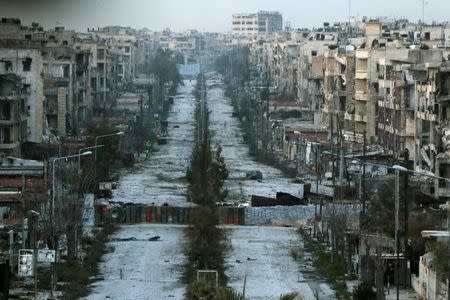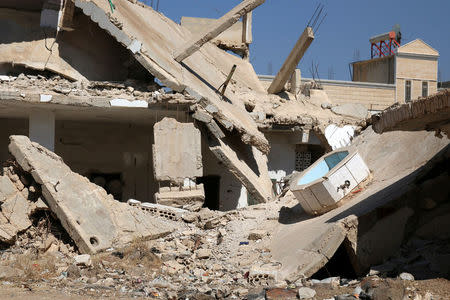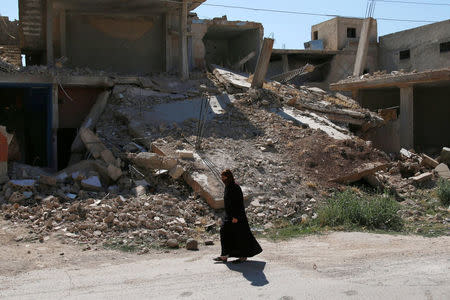Syrian army fire cuts only road into rebel-held Aleppo
By Lisa Barrington and Tom Perry BEIRUT (Reuters) - Syrian government forces took a step toward completely encircling rebel-held parts of Aleppo on Thursday, capturing ground overlooking the only road into the opposition half of the city and effectively putting those areas under siege. The army's advance toward the Castello Road, which brought it to within its firing range, came during a 72-hour ceasefire announced by the Syrian army on Wednesday, which a monitoring group said had been a ruse. Rebels said they were fighting to retake lost positions and re-secure the road. Its capture brings the Syrian government closer to its long-standing objective of encircling rebel-held areas of the northern city. Aleppo, which was Syria's largest city before the civil war with a population of more than 2 million people, has been divided for years into rebel and government sectors. Heavy aerial and artillery bombardment had at times made the Castello Road impassable. But Thursday's advance brings government forces the closest so far to the road, making it even easier to hit and effectively cutting off the opposition-held sector of the city near the Turkish border. "Currently nobody can get in or out of Aleppo," Zakaria Malahifji of the Aleppo-based rebel group Fastaqim told Reuters. He said government-allied forces were being aided by Iranian fighters and that reinforcements on the government side had arrived from further south. A senior official in another Aleppo-based group, Jabha Shamiya, said the majority of the attacking forces were Lebanese and Afghan. The Syrian Observatory for Human Rights said the advance by pro-government forces in the al-Malah Farms area had brought them to within one km (less than a mile) of the road. The army said what it described as terrorist groups had tried to attack army positions in the area, and that it thwarted this assault and had taken over the southern al-Malah farms, coming to within firing distance of the Castello Road. Pro-Damascus TV channels showed footage of tanks and troops firing and of the areas captured, which consisted of flat farmland and a number of buildings reduced to rubble. A second rebel official with fighters in the area said: "All the factions sent reinforcements and are trying to take back the positions taken by the regime, but the situation is very bad. There was heavy regime air cover in the night." A U.S. intelligence official, speaking on condition of anonymity, said Syrian and Russian forces appeared to be pressing their offensive to encircle some 250,000 people inside areas of rebel-held northern Aleppo despite the announced 72-hour nationwide ceasefire and an all-but collapsed cessation of hostilities declared by the United States and Russia in February. "Syrian regime forces with Russian firepower in recent weeks have intensified their efforts to isolate and encircle opposition forces in Aleppo," said the U.S. official. "The purpose of these attacks appears to be a campaign to sever opposition supply lines into the city through Castillo Road. This campaign exacerbates an already dire humanitarian situation and sets the stage for a humanitarian catastrophe." The Syrian Observatory estimates that between 250,000 and 300,000 people live in opposition-held parts of Aleppo. Syria's civil war, now in its sixth year, has killed at least 250,000 people, displaced more than 6.6 million inside the country and forced another 4.8 million to flee, many seeking refuge in Europe. CEASEFIRE U.S. Secretary of State John Kerry on Wednesday had welcomed the Syrian army's announcement of the truce, adding that discussions were underway to try to extend it. On Thursday, the State Department said it was deeply disturbing that Syrian forces were continuing attacks in areas such as Aleppo and the Damascus suburbs and urged Russia to exert pressure on the Syrian government to halt such attacks. France's foreign ministry said a three-day truce was not enough to start fresh peace talks, which broke down earlier this year in Geneva, and that it would judge the truce announcement by "concrete results on the ground." The Syrian Observatory said the truce was simply a way for Damascus ally Russia to show it supported a ceasefire, while the government side simultaneously took advantage of it to stage its assault near Aleppo. Aid agency Mercy Corps said the latest fighting and the almost immediate breakdown of the announced ceasefire had further constricted access to Aleppo residents, 75,000 of whom in the east of the city rely on its assistance each month. President Bashar al-Assad's military hand has been strengthened by Russian air strikes that have been underway since September. Last month, Assad's allies in the Iranian-backed Lebanese group Hezbollah said they would send more fighters to the Aleppo area. The group's leader said the defense of Aleppo was tantamount to the defense of Damascus. Earlier this year, pro-government forces including Shi'ite militias severed a separate important route north of Aleppo into opposition-held parts of the city. Assad's allies say they are battling the al Qaeda-linked Nusra Front in Aleppo. Groups fighting under the banner of the Free Syrian Army (FSA) say however that they control the rebel-held part of the city. Some of the FSA groups have received military support from Assad's foreign enemies, including Turkey and the United States. The Nusra Front has meanwhile played a significant role in fighting against pro-government forces southwest of Aleppo. (Reporting by Lisa Barrington and Tom Perry; Additional reporting by John Davison in Beirut and Jonathan Landay and Arshad Mohammed in Washington; Editing by Tom Perry and Tom Brown)





